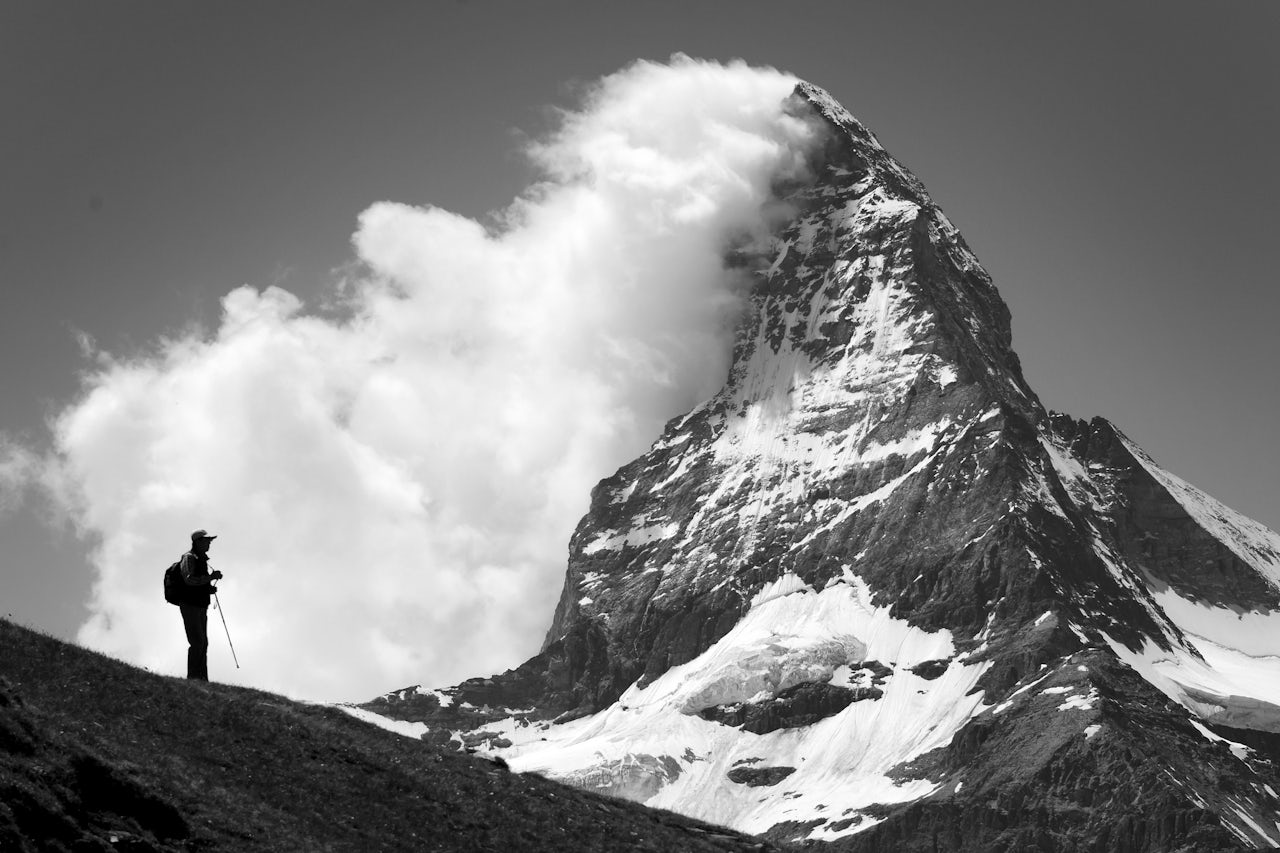YouTube user Martyupnorth really likes to hike. He likes day hikes, he likes overnight backpacking trips, he likes hiking alone, with his family, and with his dog. And he documents much of it on his YouTube channel, where more than 10,000 subscribers tune in to watch him trek through the wilderness and offer observations, tips, and tricks for those interested in following in his literal footsteps.
Everything from zit-popping to ASMR has found worldwide audiences on YouTube, so hiking videos aren’t the weirdest niche the website has to offer. But it is surprising that footage of people walking through the woods is as popular as it is. Almost every experience is filmed nowadays, but the nature of outdoor activities like hiking and backpacking make this genre of uploads seem particularly odd. Hiking, after all, is about going off the grid and leaving the busy, modern world behind to explore calm, natural settings.
Wilderness memoirs and state tourism ads characterize hiking and backpacking as activities that are as much about reconnecting with nature as they are about finding yourself. There’s a kind of spirituality attached to outdoor recreation that sports like soccer or racecar driving don’t have. And it’s a connection that’s existed long before hiking’s popularity began to soar after World War II. “As America was industrializing in the 1800s, as cities grow and become grittier and more polluted and more crowded, going to the woods becomes an escape. And it was with that idea of rejuvenation and reinvigorating oneself [that outdoor activities became desirable],” explained Forest History Society historian James Lewis in a phone call.
Hiking videos are largely uneventful and charming in their amateurish craftsmanship, but they also reveal the duality of such outdoor activities. On the one hand, they are fun and healthy, and offer a chance to “discover” the natural world and, in the process, “discover” yourself. But on the other hand, hiking and backpacking can be experiences as manufactured as a trip to an amusement park or the mall. “Here in the United States, there’s nothing that we won’t commercialize and commoditize,” said Lewis. The exploration and “discovery” aspect is inspired by environmentalism at its best. But at its worst, it’s a byproduct of settler colonialism, the same force that violently emptied those lands of their original inhabitants and set them aside for recreational purposes in the first place.
The role of hiking in the public consciousness is exemplified by Cheryl Strayed’s 2012 best-selling memoir Wild: From Lost to Found on the Pacific Crest Trail, which was adapted into the 2014 film Wild starring Reese Witherspoon. In both, Strayed’s solo 1,100-mile hike on the PCT in 1995 is portrayed as a spiritual journey of self-discovery, a way of healing from the death of her mother and the collapse of her marriage. Strayed finds redemption at the end of her backpacking trip, when she arrives at the Bridge of the Gods on the Oregon/Washington border. But the Trail’s redemptive potential is underscored by the real-life professional success she found as a result of writing and publishing the book. (In last year’s Netflix-produced season of Gilmore Girls, one character attempts to “do Wild” by hiking the PCT herself.)
For people who follow hiking YouTube, strangers’ videos are as close to the trails as they can get when they can't actually be outside.
Wild brought Strayed international recognition, but it also increased the popularity of hiking and backpacking, especially on the Pacific Crest Trail. And the folks who run the massively popular trail seem to embrace the marketing opportunity with open arms. The Pacific Crest Trail Association website features a special Wild section where you can find out how to “hike where Cheryl hiked.” And one part of the trail, the Tehachapi Pass, is described by the PCTA as not being particularly scenic but holding the potential for the type of “wonder, astonishment, and self-discovery” that Strayed experienced in her book. Likely as a result, PCT hiking videos are among the most common of the genre. And aspiring hikers can become familiar with its different sections before they even apply for trail passes or lace up their first pair of hiking boots.
Unlike many fitness fads past, hiking really does encourage good physical and mental health while promoting the preservation and care of precious natural environments. For many hikers, the activity is a spiritual exercise. But that characterization can obscure its commercial value. Today, hiking is a huge industry in the U.S. Over 34 million people took to the trails in 2013 alone, according to the American Hiking Society. And Americans spend $646 billion on outdoor recreation gear each year, The Outdoor Industry Association reports.
Hiking videos may very well serve the purpose of preserving their creators’ fond memories and sharing them with the world. But they also act as a Yelp of sorts for the trails and campsites they document, as well as semi-commercials for the gear that is featured. It’s easy to criticize the genre as narcissistic, materialistic, or, even worse, boring. But, as with all miracles of modernity, they’re not all bad. They unravel the idea of outdoor activity as a pure experience, revealing a culture obsessed with not only preserving any and all experiences but anticipating every aspect of those experiences as well. Whereas past generations of hikers set out into the “unknown,” hikers today don’t have to contend with that sense of mystery if they don’t want to. And indeed, it can feel like something is lost with every mile of trail uploaded to YouTube.
Martyupnorth’s most popular video is a 24-minute montage, “Solo 3-day backpacking hike in Banff Rocky Mountains.” In the video, he’s hiking through the British Columbian wilderness equipped with a backpack and a camera. Footage of him walking and talking about trail conditions is interspersed with panning shots of Rocky Mountain splendor and still shots of practical activities like setting up his tent, rolling and unrolling his sleeping bag, building a fire. A sporadic soundtrack features instrumental versions of songs by Madonna and U2. And while it lacks professional polish (at one point, when he sits on his pack to speak directly to the camera, the top half of his head is out of the frame) the subdued tone and lack of any real “action” makes the video almost hypnotic.
Its pure entertainment value is debatable, but Martyupnorth has found an audience. “Solo 3-day backpacking hike in Banff Rocky Mountains” has been viewed over 460,000 times, and it’s only one of many YouTube videos capturing the heavy breathing and leaf crunching of someone walking through the woods. The much more talkative sintax77 has attracted over 50,000 subscribers on YouTube. His most recent video, “Hiking the Grayson Highlands - Solo Backpacking Trip,” surpassed 7,000 views within 24 hours of being posted. One video of a man pointing his GoPro at himself as he hikes to and then up the Haiku Stairs in Oahu, Hawaii, has inexplicably racked up over 1 million views since it was posted in 2012, despite its abrasive soundtrack and complete lack of commentary from its creator.
Hiking videos reveal the often-ignored commercialized aspect of outdoor recreation, but they can also create global communities around the sport, perhaps making it more and more accessible to those who can’t, or simply don’t know how to, participate. A quick reading of the comments on some of these videos highlight their positive effects. “These videos are great, it makes me feel like I'm out there hiking with a buddy,” wrote one YouTube user in reaction to an upload by Martyupnorth. “Could you please do a video where you show how to attach an underquilt?” another viewer asked of sintax77, who responded that he���ll keep it in mind for an upcoming video.
For people who follow hiking YouTube, strangers’ videos are as close to the trails as they can get when they can't actually be outside. Whether that type of digital access to a decidedly analog activity is good or bad is up for debate. But either way, hiking videos are there if you want to watch someone go for a walk. Or if you want to get up and take a hike of your own.

